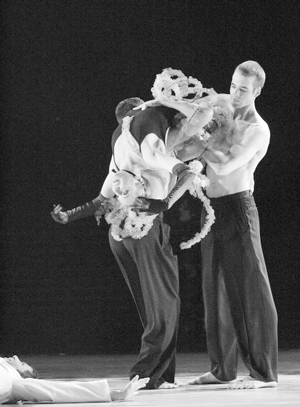A multicolored, inclusive, and sideways “Sleeping Beauty” at DTW
Fairy tale history repeats itself in Donald Byrd’s complex layered collage. The subject is Marius Petipa’s “Sleeping Beauty,” considered the Bible of ballet. Byrd calls his sideways consideration “The Sleeping Beauty Notebooks.” The white, ballet-trained dancers of the Seattle-based Spectrum Dance Theater—where several years ago Byrd accepted an appointment as artistic director––perform the multicolored and inclusive interpretation wonderfully.
Byrd’s research is revealed in supertitles with bright truisms about “Sleeping Beauty.” Dancer-storytellers with Deep South patois stir up the original’s inconsistencies, re-telling bits, sometimes with farcical effects. Though everyone in this stage kingdom falls asleep, not so the spectators of the two-hour production.
The lavish Imperial trappings of the original 1890 “Beauty” are reflected in the spirit if not the letter of “Notebook.” Craig Wollam’s set is high-tech; everything is exposed, including the dressing room. Christina Cooley enters as the Lilac Fairy on a genie lift. She wears a black leotard with curled multicolored coils that inventively say ‘tutu.’ Her arms in long black gloves gesture with generosity as she presents her good works—she reduces Princess Aurora’s sentence of death by finger prick to 100 years sleep.
The eminent historian Thomas DeFrantz is also “Notebook’s” dramaturge. He takes the pulpit and questions the audience about the “dark fairy” Carabosse, and whether she is a terrorist. Danielle Wilkins plays the ranting fairy, the persona non grata who wasn’t invited to Aurora’s christening. In a second vengeful incarnation, Julia Wilkins’s Carabosse wields a voodoo Barbie.
Notions of good and evil are not so black and white in “Notebook.” The barefoot fairies can be scary or sweet. In a lusty bar scene, they wear teddies and play at consummating their desire with the three males, who double as Aurora’s suitors. A glutinous supper scene—could it be the last?—ends in simulated tabletop sex. Laura Seefeldt as the Princess twirls around the stage with pert perfection and does a marvelous Rose Adagio, twinkling in spite of her stiletto heels. Seefeldt’s insipid Aurora deserved robust applause.
Lavish presentation is a laughing matter—even set to the crashing Tchaikovsky recording—but in the final pages of this “Notebook” substance can be found in the “happily ever after.” The ‘grand’ duet offers a paradigm of love in which nuptial bliss is about caring for one another, as danced with vivid charge by Julia Wilkins and David Alewine.
Or was it just a fairy tale?
gaycitynews.com



































